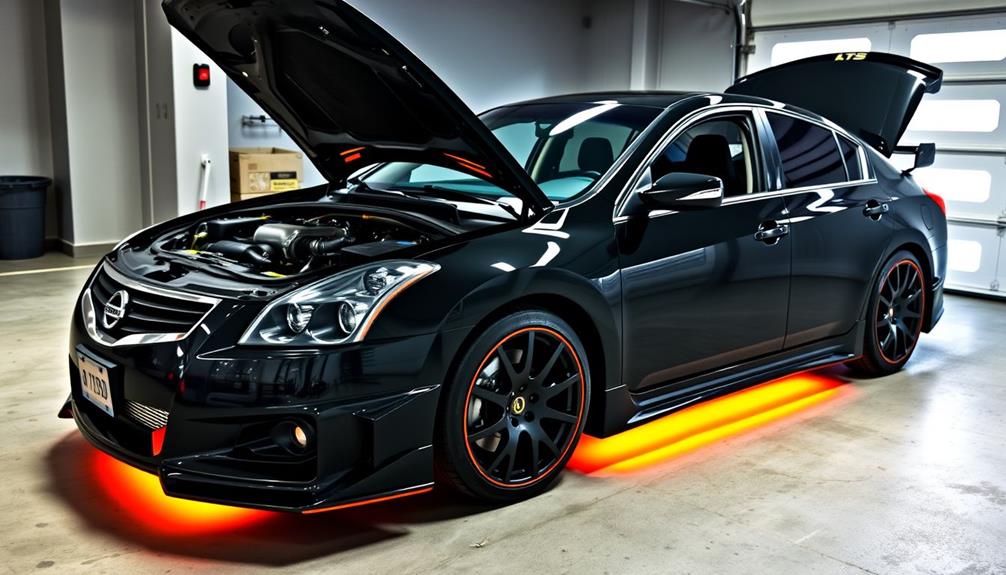Tuning your 2015 Ford Escape can greatly boost both power and efficiency, making your SUV more enjoyable to drive. With options like custom tunes from Livernois Motorsports and SCT tuners, you can enhance your 2.0L Ecoboost engine, potentially increasing power by over 36 WHP and improving fuel efficiency by up to 15%. Upgrades like throttle enhancers and performance air intakes further refine your driving experience. Installing these tuners is straightforward and typically takes around 15 minutes. As you enhance performance, you'll enjoy smoother acceleration and better overall handling—discover how these improvements can transform your SUV journey.
Key Takeaways
- Tuning the 2015 Ford Escape, especially the 2.0L Ecoboost engine, can yield power gains of over 36 WHP and 77 WTQ.
- Custom tuning options from Livernois Motorsports and RaceChip enhance performance and fuel efficiency, potentially improving MPG by up to 15%.
- Installation of tuners is straightforward, typically completed in about 15 minutes with user-friendly features for DIY enthusiasts.
- Upgrading components like air intake systems and exhaust enhances airflow, further boosting engine performance.
- Regular maintenance and proper tuning can extend engine longevity while providing an engaging driving experience.
Overview of Ford Escape Tuning
Tuning your 2015 Ford Escape can really boost its performance and transform your driving experience. With its 2.0L Ecoboost engine, you've got a solid foundation for tuning that can greatly enhance horsepower and torque.
By choosing the right tuning options, like custom tunes from Livernois Motorsports or Torrie from Released Tuning, you can expect impressive performance gains. Just remember to verify your PCM serial number for the best results.
Through proper tuning, you could see increases of over 36WHP and 77WTQ, with max gains potentially exceeding 46WHP and 83WTQ when opting for a performance tune.
Aftermarket tuning devices, such as the SCT tuner, allow you to fine-tune fuel mapping and ignition timing, improving both throttle response and overall drivability.
However, it's vital to approach tuning with care. Proper methods are essential to avoid any risk of engine damage.
Engaging with community discussions and shared experiences can provide valuable insights that enhance your tuning process. By understanding the various aspects of tuning for your Escape, you'll set yourself up for a more powerful and efficient ride.
Benefits of Tuning Your SUV

Enhancing your 2015 Ford Escape through tuning brings a multitude of benefits that go beyond just increased horsepower and torque. You can expect significant gains, with potential improvements of over 36WHP and 77WTQ. This boost in power levels translates into better acceleration and overall performance, making every drive more exhilarating.
Custom tuning options allow you to tailor your Escape's performance to match your driving style. Whether you prefer spirited drives or fuel-efficient commuting, tuning can adjust your power levels to meet those needs. Improved throttle response and shifting dynamics also make your SUV feel more engaging and responsive, enhancing drivability in everyday conditions.
One of the most appealing benefits is the potential for better fuel efficiency. With some modifications, you might see an improvement of up to 15% in MPG, leading to noticeable cost savings at the pump.
Additionally, advanced tuning technology, such as data logging capabilities, enables real-time performance monitoring and adjustments. This guarantees that your engine runs at peak performance, contributing to its longevity.
Key Performance Upgrades

When it comes to releasing your 2015 Ford Escape's full potential, key performance upgrades can make a world of difference. One of the most impactful upgrades is a custom tune, like those offered by Livernois Motorsports. With a performance tune using 93 octane fuel, you can gain up to 36 horsepower and 77 lb-ft of torque, enhancing your driving experience greatly.
In addition to power gains, proper tuning optimizes fuel mapping and air/fuel management, which can boost your fuel economy by as much as 15%. This means you not only enjoy a more powerful ride but also save at the pump.
You might also consider adding the Livernois Motorsports Infinite+ Throttle Enhancer, which improves throttle response for better acceleration and responsiveness.
With additional tune options available, you can customize your Escape's performance further, with prices ranging from just $10 for one extra tune to $40 for four.
These key performance upgrades guarantee that you maximize both power and efficiency in your Ford Escape, giving you a more enjoyable and economical driving experience.
Tuning Options and Customization

When it comes to tuning your Ford Escape, you've got some exciting options to explore.
From the Livernois Motorsports MyCalibrator Touch's performance tunes to RaceChip's adaptable mappings, you can greatly enhance your ride's performance.
Plus, customization features allow you to tailor your tuning strategy to fit your driving style and needs.
Available Tuning Options
Exploring the available tuning options for the 2015 Ford Escape reveals a range of customizable solutions designed to enhance performance and efficiency. One standout choice is the Livernois Motorsports MyCalibrator Touch, which offers a 93 octane performance tune. This option can deliver impressive gains of over 36 WHP and 77 WTQ, making it a top pick for those serious about boosting their SUV's power.
You can also expand your tuning flexibility with additional options. For just $10, you can add one more tune, or for $40, you can gain access to four additional tunes.
If you're looking for a different approach, RaceChip tuning provides various performance levels, from the solid RaceChip S to the premium RaceChip GTS Black. The latter can potentially improve your MPG by up to 15%.
Installing these tuning devices is usually straightforward, thanks to the Plug&Drive principle. This ease of installation means even DIY enthusiasts can take on the task with minimal effort.
Plus, with data logging capabilities, you can monitor performance metrics and make real-time adjustments for peak engine performance based on specific driving conditions.
Customization Features Explained
Releasing the full potential of your 2015 Ford Escape is easy with a variety of customization features designed to enhance your driving experience.
One standout option is the MyCalibrator Touch, which provides multiple tuning levels tailored for both gasoline performance and towing. This means you can fine-tune your Escape for any occasion.
If you want to expand your tuning capacity, you can purchase additional options, starting from just $10 for an extra tune up to four tunes for $40. This flexibility allows you to cater your tuning to specific performance needs.
Moreover, the customization features include data logging capabilities, enabling you to track performance metrics and adjust your settings for ideal results based on your preferences and driving conditions.
With support from Livernois Motorsports, you get expert help with fuel mapping, air/fuel management, and revised boost control, all aimed at improving power delivery.
As a result, you'll experience enhanced throttle response and improved shifting, creating a more engaging driving experience while boosting efficiency in your 2015 Ford Escape.
Performance Enhancement Strategies
Releasing the full potential of your 2015 Ford Escape goes beyond basic customization; it involves implementing various performance enhancement strategies.
One effective option is the Livernois Motorsports MyCalibrator Touch, which offers tuning levels that can deliver peak gains of over 36 WHP and 77 WTQ with a 93 octane performance tune. If you want a more tailored approach, custom tuning options allow you to select additional tunes for specific performance needs, with prices as low as $10.
Another valuable enhancement is the Pedal Commander device, which improves throttle response and acceleration. It offers multiple driving modes, including ECO and Sport, optimizing your driving experience without altering the vehicle's horsepower.
For those seeking even more power, RaceChip tuning modules provide various performance levels, from the RaceChip S to the RaceChip GTS Black, allowing you to fine-tune your Escape's capabilities.
Installation Process for Tuners
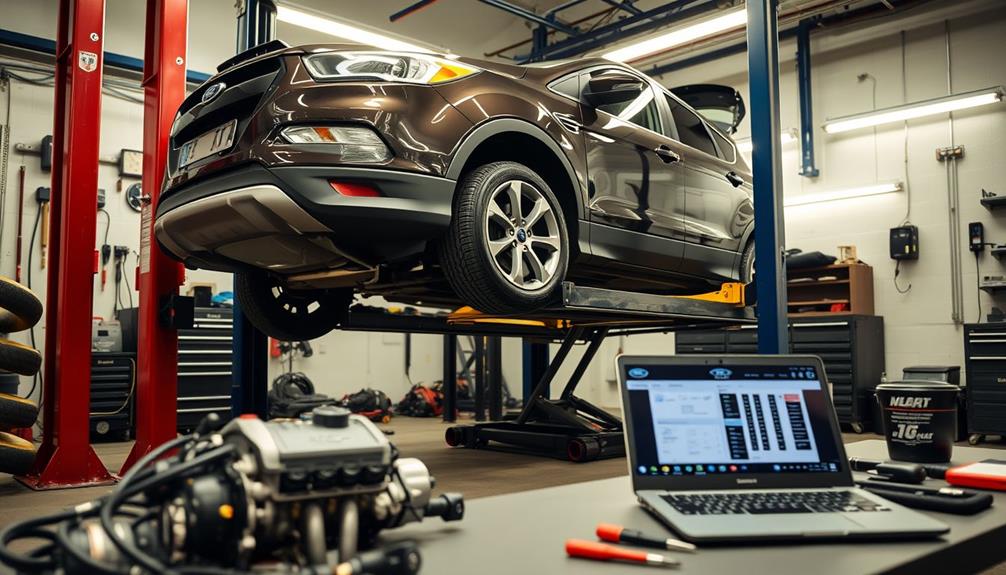
Installing a tuner for your 2015 Ford Escape is a straightforward process that typically takes just about 15 minutes. Most tuners follow a Plug&Drive principle, allowing you to set it up with minimal hassle. First, locate your engine codes in your service booklet or on engine bay stickers; this guarantees your tuning device is compatible.
Here's a quick overview of the installation process for tuners:
| Step | Description | Time Estimate |
|---|---|---|
| 1. Gather Tools | Collect necessary tools and tuning device. | 2 minutes |
| 2. Connect Device | Plug the tuner into the OBD-II port. | 5 minutes |
| 3. Software Update | Follow instructions for any software updates. | 8 minutes |
Most tuners come with detailed fitting instructions and wiring kits to guarantee a secure installation. If you encounter any issues, technical support is typically available, making this process accessible even for those without extensive mechanical experience. Plus, you can enjoy real-time fine-tuning options via mobile apps, allowing you to adjust performance settings conveniently.
Understanding Powertrain Warranty

When considering a powertrain warranty for your Ford Escape, it's vital to understand what it covers and any limitations that may apply.
This warranty typically protects essential components like the engine and transmission, but there are exclusions you should be aware of.
Knowing these details can help you make informed decisions, especially if you're planning on tuning your vehicle.
Warranty Coverage Details
Understanding the nuances of the Ford Escape's powertrain warranty can be essential for your peace of mind, especially if you're considering tuning your vehicle. The optional Limited Powertrain Warranty is priced at $1,000.00 but can be snagged for a reduced price of $599.99, providing coverage for vital powertrain components. This warranty isn't available in California due to state regulations, so keep that in mind.
Having this warranty coverage is a great way to protect yourself against potential failures, especially after tuning your Escape for enhanced performance. Depending on the options you select, the coverage can last from 2 to 5 years, which boosts your confidence in your vehicle's capabilities.
Here's a quick overview of the warranty options:
| Warranty Option | Price | Coverage Duration |
|---|---|---|
| Standard Powertrain | $1,000.00 | 2 to 5 years |
| Discounted Powertrain | $599.99 | 2 to 5 years |
| California Availability | N/A | N/A |
| Protection Against Failures | Yes | Yes |
With this warranty, you can feel secure while enjoying your tuned Ford Escape.
Limitations and Exclusions
While having warranty coverage can provide peace of mind after tuning your Ford Escape, it's important to be aware of its limitations and exclusions. The optional Limited Powertrain Warranty, which costs $1,000 or an alternative $599.99, covers essential powertrain components but has specific conditions.
For instance, this warranty isn't available for sale in California, limiting access for residents there. Additionally, the coverage typically lasts between 2 to 5 years, depending on the terms you agree upon at purchase.
However, understanding the warranty's limitations is vital. Certain modifications or tuning could void the warranty, especially if they're not performed according to manufacturer guidelines. This means that if you decide to upgrade your Escape for better performance, any non-compliant modifications might leave you without coverage if issues arise.
To protect your investment and guarantee you're covered, always consult the warranty details and consider how your tuning choices might affect it. Being informed about these exclusions can save you from unexpected repair costs down the line, helping you maintain both power and peace of mind.
Fuel Efficiency Improvements

Tuning your 2015 Ford Escape can greatly boost fuel efficiency, helping you save at the pump. By optimizing your engine's performance, you can achieve fuel efficiency improvements of up to 15%.
One effective way to enhance fuel economy is through a performance tune that optimizes air/fuel management and ignition timing. This not only increases your MPG but also reduces harmful emissions.
Replacing faulty components, like an oxygen sensor, can further elevate your fuel mileage by up to 40%. Regular maintenance and tuning are essential, as they can enhance overall vehicle efficiency by as much as 25%, ensuring your engine operates at peak performance levels.
Aftermarket tuning options provide an excellent opportunity to achieve these gains without sacrificing power. With improvements in fuel mapping, your Escape will use fuel more efficiently, allowing you to enjoy a smoother driving experience.
Incorporating these tuning measures means you're not just enhancing your SUV's performance; you're also making a positive impact on your wallet and the environment.
Enhancing Throttle Response
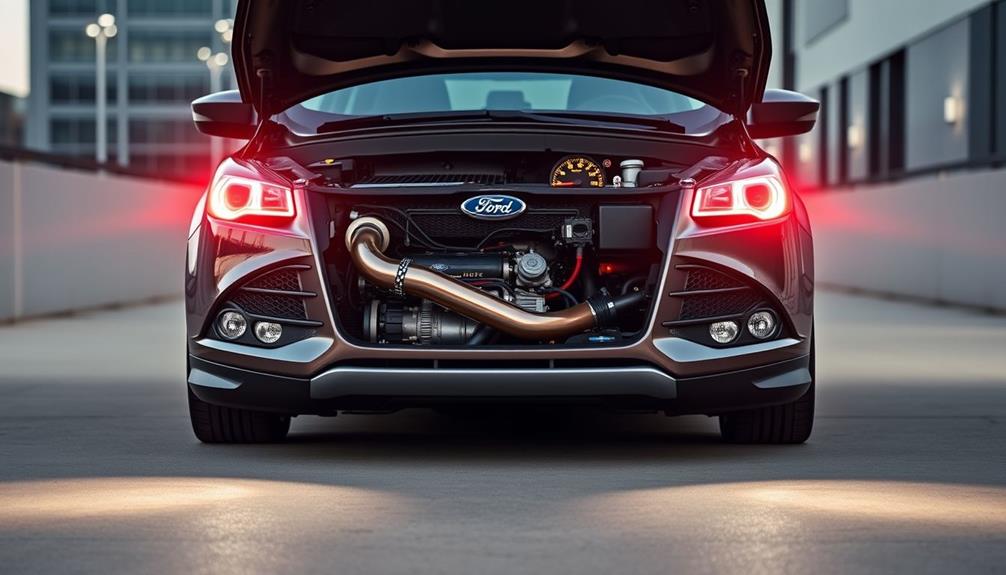
Enhancing throttle response in your 2015 Ford Escape dramatically boosts drivability, making acceleration quicker and driving more engaging. By upgrading to a Livernois Motorsports Infinite+ Throttle Enhancer, you've got precise control over throttle response, optimizing your vehicle's performance for various driving conditions.
This upgrade not only transforms how your SUV feels but also enhances overall efficiency.
With aftermarket tuning solutions like the MyCalibrator Touch, you can access peak gains of over 36WHP and 77WTQ, resulting in improved throttle sensitivity. These gains allow for a more responsive driving experience, whether you're maneuvering city streets or cruising on the highway.
Custom tuning options enable you to tailor your vehicle's throttle response to your preferences, ensuring that your Escape delivers the performance you desire.
Moreover, enhancing throttle response contributes to better fuel efficiency by allowing smoother power delivery during driving. This means you can enjoy a lively driving experience without sacrificing economy.
Maintaining Engine Longevity
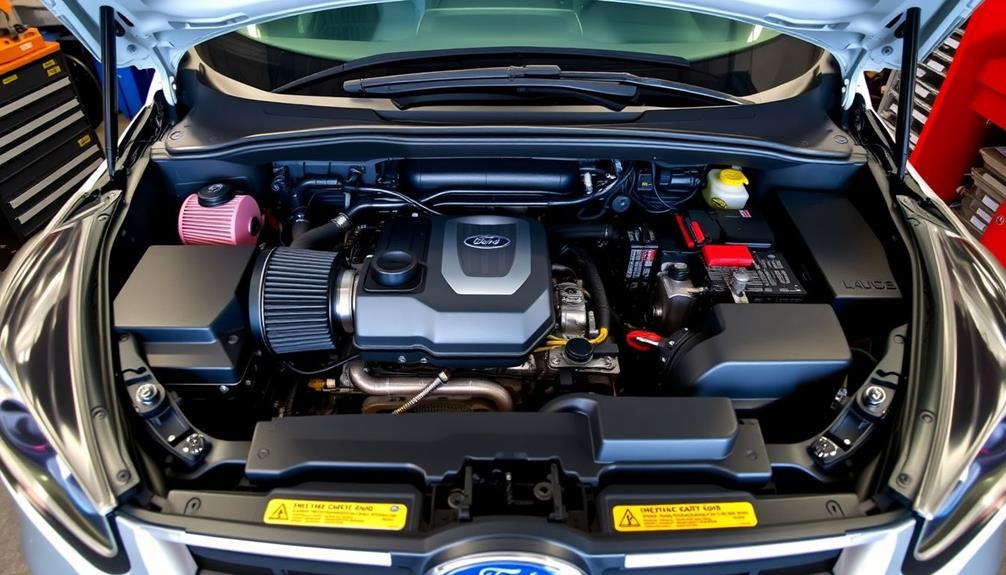
To guarantee your 2015 Ford Escape runs smoothly for years to come, regular maintenance is key. By prioritizing tasks that support maintaining engine longevity, you can avoid expensive repairs and enjoy better performance. Here's a quick overview of essential maintenance tasks:
| Maintenance Task | Importance | Frequency |
|---|---|---|
| Engine Tuning | Improves fuel mileage by up to 4% | Every 5,000 miles |
| Change Fuel Filters | Essential for peak engine health | Every 15,000 miles |
| Replace Spark Plugs | Boosts efficiency, up to 25% gain | Every 30,000 miles |
Implementing a Warm-Up Timer feature helps your engine reach peak performance without the risk of premature wear during cold starts. Additionally, make sure you're using the manufacturer's recommended oil grade—using the wrong type can decrease fuel economy by up to 2%. Regularly check your tire pressures, as proper inflation enhances safety and can improve fuel economy.
Recommended Tuning Products
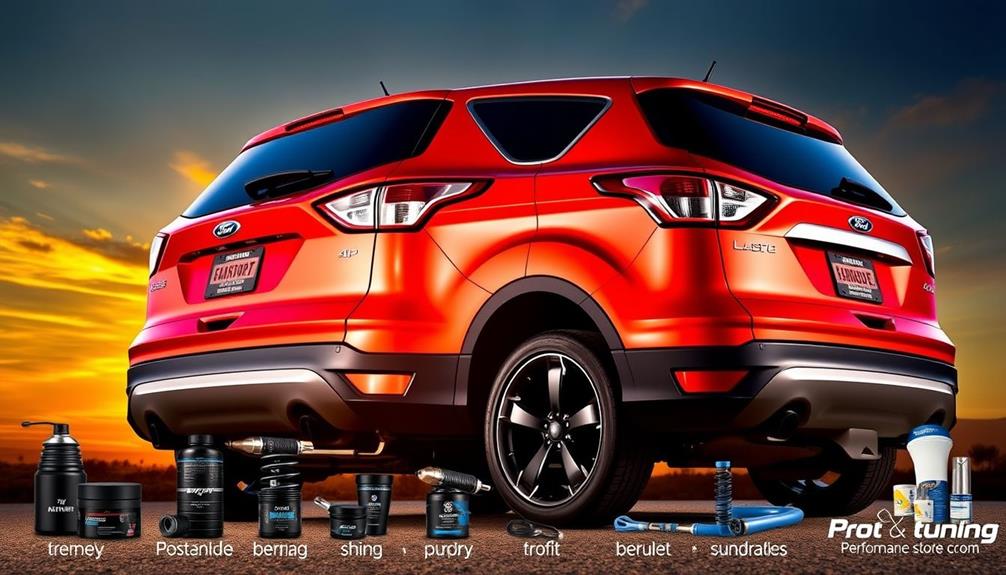
When looking to boost your 2015 Ford Escape's performance, several recommended tuning products can make a significant difference. One standout option is the Livernois Motorsports Infinite+ Throttle Enhancer, priced at $299.99. This product enhances throttle response and overall drivability, providing a more engaging driving experience.
Another excellent choice is the MyCalibrator Touch, which offers multiple tuning levels. With a performance tune, you can achieve peak gains of over 36WHP and 77WTQ. Plus, you can expand your tuning options with additional tunes starting from just $10.00.
If you're considering a thorough upgrade, RaceChip models like the GTS Black deliver impressive results. These chips can boost performance by up to 15% in MPG while increasing horsepower and torque to match your specific driving conditions.
For added peace of mind, consider the optional Limited Powertrain Warranty, available for $1,000.00 or $599.99, which covers powertrain components after modifications.
Investing in these recommended tuning products will guarantee your Ford Escape not only performs better but operates efficiently, enhancing your overall driving experience.
Frequently Asked Questions
How Much Horsepower Does a 2015 Ford Escape 2.0 Ecoboost Have?
The 2015 Ford Escape with the 2.0L Ecoboost engine produces about 240 horsepower. You'll appreciate its turbocharged design, which enhances performance while maintaining fuel efficiency, making it a great choice for various driving conditions.
Is the 2015 Ford Escape Fuel Efficient?
You might think fuel efficiency's just average, but the 2015 Ford Escape actually impresses. With the right maintenance and tuning, you can enjoy up to 15% better mileage, enhancing both your driving experience and savings.
What Is the Best Engine in the 2015 Ford Escape?
You'll want the 2.0L EcoBoost engine for the 2015 Ford Escape. It delivers 240 horsepower and 270 lb-ft of torque, offering the best combination of power and efficiency for your driving experience.
How Much Power and Torque Does a Ford Escape Have?
When you consider a Ford Escape, you'll discover different engine options delivering diverse dynamics. The 2.5L produces 168 horsepower, while the 2.0L EcoBoost boasts a powerful 240 horsepower and impressive torque at 270 lb-ft.
Conclusion
To sum up, tuning your 2015 Ford Escape is like fine-tuning a musical instrument; it brings out the best in your ride. Imagine transforming your SUV from a simple melody into a symphony of power and efficiency. With the right tweaks, you’ll not only enjoy a boost in performance but also experience smoother handling and better fuel economy. So, don’t hesitate—unlock your Escape’s true potential and hit the road with a newfound rhythm! If you’re ready to take your 2015 Ford Escape to the next level, consider exploring the world of Ford Escape performance tuning. By working with a professional tuner, you can customize your vehicle’s engine, transmission, and other components to optimize its overall performance. Whether you’re looking for increased horsepower, improved torque, or enhanced fuel efficiency, ford escape performance tuning can help you achieve your goals. So, why settle for a standard ride when you can elevate your driving experience with expert tuning?










